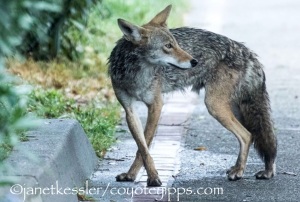I advised some dog walkers that a coyote was around a bend. They ignored me until the coyote was at the top of the hill and could actually be seen. One of the women turned to me and said “mighty aggressive I would say”. I asked why she thought this — the coyote was just standing on the same path as she was.
I had been watching the coyote hunt, and it just happened to be headed in the direction of the walkers. It couldn’t possibly have seen the walkers to avoid them, just as the walkers could not possibly have seen the coyote. The woman turned to me and said that the coyote was obviously after them — if he hadn’t seen them, he surely could have HEARD them, and, weren’t coyotes SUPPOSED to be afraid of us? Didn’t that constitute aggression?
No, that does not constitute aggression.
And no, coyotes are not necessarily fearful of people — rather, it would be more accurate to say that coyotes are WARY of people. They will do their utmost to avoid people. But closer encounters in a park will happen now and then. The coyote may look at you, and may even study you for a moment — that is not aggression — that is curiosity, or even surprise. And then he will move away. Coyotes are not at all interested in people. In this case, the coyote came within about 50 feet of the woman and her dog which was leashed. Both parties gazed at each other for a moment and then the coyote ran off the path.
Recap of dog/coyote behavior: Though not frequent, instances of dog/coyote encounters have occurred. A short leash and walking on can prevent an incident. Coyotes have shown an interest in some dogs — dogs and coyotes, after all, are very similar in appearance. Young coyotes have expressed degrees of curiosity about dogs, and even attempted friendly play — but they remain skittish and ready to flee at the slightest startle.
However, parents tend to be defensive of their territories and their young, and they prefer greater distances between themselves and dogs. If your dog comes too close, the coyote — especially if it is an alpha — may feel threatened and act accordingly, with definite and clear MESSAGES to your dog. These messages progress from a very cat-like defensive posture: arched back and snarly face, to a short charge-and-retreat sequence, and, ultimately, it may attempt to nip the dog at his haunches — trying to herd it away, in the same fashion that cattle dogs do. When they do so, they are not attempting to do anything more than TELL the dog something in the only way they can: ” go away”, “give me space”. Keeping your dog on a short leash and moving on and away from the coyote helps guard against this type of coyote reaction in an unexpected encounter. You may have to go so far as to flail your arms and yell at the coyote to back off.
Your dog may want to chase or play with a coyote it sees, or may even feel a need to protect you against a wild animal it is not sure about. It is important to keep your dog next to you and calm, and to walk away quickly before there is time for a possible antagonistic communication to escalate if it has already begun. By doing this, you are messaging your own disinterest in the coyote. But do not run because running might be interpreted as an invitation for the coyote to chase you.
Coyotes have run after some dogs, seemingly unprovoked by the dog himself, and exhibited the messaging behaviors I mentioned above. As far as I have seen, this always occurs when there has been previous chasing by the dog or antagonistic communication between the two — a communication few humans are aware of. Dogs and coyotes communicate exceeding effectively through eye contact and body language. In addition, highly spirited dogs — as many small dogs are — seem to raise the ire of some coyotes: Coyotes seem to want the dogs passing through their territories to be fairly calm: a super active dog is cause for alarm, and this assessment extends to as well to transient or interloper coyotes. The oddest behavior of a coyote towards a dog that I’ve seen was a coyote who slowly followed a dog which was trailing behind its owner — stretching to reach the dog’s tail as if it were “daring” itself to do so. The owner turned around just as the coyote reached the dog and simply said “go away”, pointing his finger instructively at the coyote, and the coyote did so!
So, please keep your dog next to you and walk on when you see a coyote! And if you need to tell a coyote who has come much too close not to come closer, you can do so by flailing your arms to make yourself appear larger, making sharp loud noises, or tossing pebbles in the coyote’s direction — not at him — to warn him off. Both people and coyotes want the same thing: space! We need to understand their methods, and we need to know what methods will work for ourselves.




Oct 05, 2011 @ 18:11:11
I don’t think this is a woman I would sit down and have a beer with; she seems completely devoid of sensitivity towards urban wildlife….
Sep 30, 2017 @ 16:25:15
Thanks for an excellent article! Being educated and keeping your dogs on leash are the answers. Personally, I’m thrilled when my dogs and I encounter coyotes on our morning hikes. :)
Sep 30, 2017 @ 16:51:28
“Wags and welcome!” — nice!